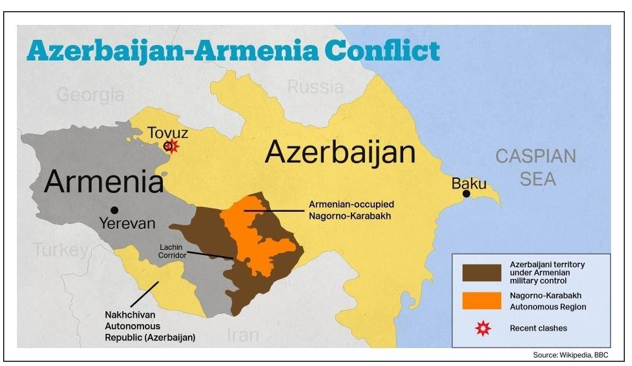SYLLABUS
GS-2: Effect of policies and politics of developed and developing countries on India’s interests.
Context:
Recently, the Azerbaijani President and Armenian Prime Minister signed an agreement aimed at ending decades-long on-off conflict, brokered by the United States.
Key Provisions of the Agreement
Permanent Cessation of Hostilities: Both countries pledged to relinquish all claims to each other’s territory, refrain from using force against one another and to respect international law.
- This includes reopening travel, business, and diplomatic relations.
Trump Route for International Peace and Prosperity (TRIPP): This corridor will connect Azerbaijan’s main territory to its Nakhchivan exclave through southern Armenia. The United States will oversee the corridor’s development, which includes highways, railways, pipelines, and communication lines.
Economic and Defence Cooperation: The U.S. lifted restrictions on military aid to Azerbaijan and signed separate trade and technology agreements with both nations, aiming to boost regional stability and growth.
Dissolution of the OSCE Minsk Group: Both countries agreed to formally disband this long-standing peace mediation group, acknowledging its diminished role.
About the Nagorno-Karabakh Conflict

- The conflict between Armenia and Azerbaijan centers on the Nagorno-Karabakh region, a disputed territory internationally recognized as part of Azerbaijan but mainly inhabited by ethnic Armenians.
- The conflict stems from historic tensions between Christian-majority Armenia and Muslim-majority Azerbaijan, dating back to the pre-Soviet era, at the crossroads of the Ottoman, Russian, and Persian empires.
- The dispute dates back to the final years of the Soviet Union, escalating into a full war from 1988 to 1994 that displaced hundreds of thousands and left Nagorno-Karabakh and surrounding areas under Armenian control.
- Tensions reignited in 2020 when Azerbaijan launched a major military offensive.
- In September 2023, Azerbaijan fully reclaimed Karabakh through swift military action, prompting over one lakh ethnic Armenians to flee to Armenia within a week.
Key significances of the Armenia–Azerbaijan peace agreement
- Strategic Transit Corridor: The U.S. secured exclusive development rights to the TRIPP, linking Azerbaijan with its Nakhchivan exclave through Armenian territory, potentially unlocking regional connectivity.
- Geopolitical Shift: The deal expands U.S. influence in the South Caucasus and sidelines Russia, historically the primary mediator in the conflict.
- Economic and Energy Cooperation: Accompanying agreements will boost energy and technology trade, with the potential to integrate Azerbaijan into broader U.S. led regional economic frameworks.
India’s Interest
- Bilateral Treaty with Armenia: Armenia is the only South Caucasus country with which India signed a Treaty of Friendship and Cooperation in 1995 a testimony to their longstanding and multifaceted bilateral relationship.
- Strategic Transit through Azerbaijan: Azerbaijan lies along the Western route of the International North–South Transport Corridor (INSTC), a multimodal freight corridor linking India to Russia via Iran and Azerbaijan.

